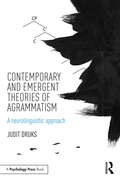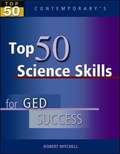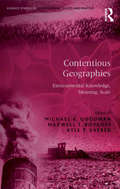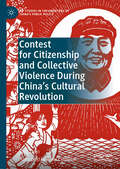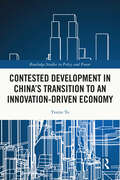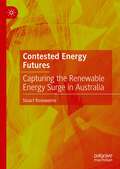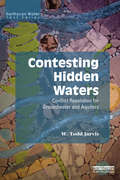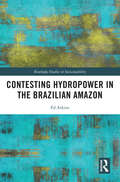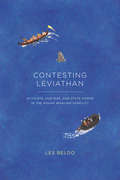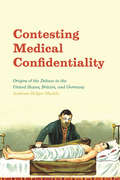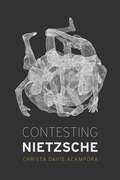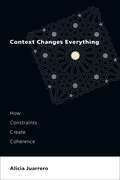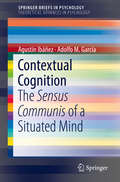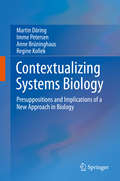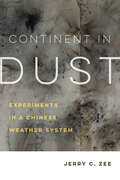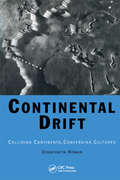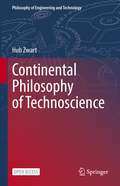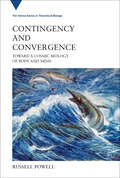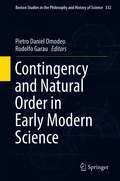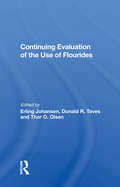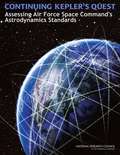- Table View
- List View
Contemporary and Emergent Theories of Agrammatism: A neurolinguistic approach
by Judit DruksContemporary and Emergent Theories of Agrammatism provides an in-depth review of the previous five decades of research on agrammatism focusing specifically on work which has been informed by linguistic theory. The final chapters reflect the recent turning point in the conceptualization of the underlying causes of the impairments agrammatic individuals present with. The book includes chapters on impairments to grammatical morphemes the tree pruning and trace deletion hypotheses verb deficits in sentences, and as single words generalized minimality adaptation theory and slow syntax the involvement of discourse To facilitate student reading the writing is clear and accessible, and the book includes a glossary of unfamiliar terms. Contemporary and Emergent Theories of Agrammatism will be of great interest to advanced students and researchers in areas such as psychology of language, linguistics, neurolinguistics, aphasiology and speech and language therapy.
Contemporary's, Top 50 Science Skills for Ged Success [Grade 9-12]
by Robert MitchellContemporary'sTop 50 . . . Skills for GED Successis a program designed toquicklyprepare students for the GED Tests. This Textbook can be used in a variety of ways: Student-directed self-study One-on-one instruction Group instruction Top 50 . . . Skills for GED Successorganizes each GED Test subject into 50 manageable skills, identified by the GED Testing Service. The format of each text is very easy to follow and is organized into instruction and practice sections. Pretest and Posttest The pretest contains a question for each of the skills most likely to be seen on the actual GED Test. The posttest is formatted just like the GED Test! Students can use the posttest to practice taking the GED test under real test-taking conditions, as well as an evaluation tool to determine readiness for the real GED Test. Lesson Format Each lesson in the text is introduced in a two-page format. The left page is the Skill Instruction page and the right page is the GED Readiness page. The GED Readiness page provides practice questions in the same format as the actual GED Test.
Content Essentials For Science, Student Handbook, Level C
by Margarita CalderonYour book has two parts, you can use the first part to learn about science topics. If you need help reading or writing about science, use the second part.
Contentious Geographies: Environmental Knowledge, Meaning, Scale (Routledge Studies in Environmental Policy and Practice)
by Maxwell T. BoykoffThe human-environment relationship - intimately intertwined and often contentious - is one of the most pressing concerns of the 21st century. Explored through an array of critical approaches, this book brings together case studies from across the globe to present significant cutting-edge research into political ecologies as they relate to multi-form contestations over environments, resources and livelihoods. Covering a range of issues, such as popular discourses of environmental 'collapse', climate change, water resource struggles, displacement, agro-food landscapes and mapping technologies, this edited volume works to provide a broad and critical understanding of the narratives and policies more subtly shaping and being shaped by underlying environmental conflicts. By exploring the power-laden processes by which environmental knowledge is generated, framed, communicated and interpreted, Contentious Geographies works to reveal how environmental conflicts can be (re)considered and thus (re)opened to enhance efforts to negotiate more sustainable environments and livelihoods.
Contest for Citizenship and Collective Violence During China’s Cultural Revolution (IPP Studies in the Frontiers of China’s Public Policy)
by Yang LijunThis book has been groundbreaking for scholars of the Cultural Revolution, but hitherto was only available in Japanese and Chinese. This edition allows English-language readers to access the work for the first time. The author explains how political struggles within the state, competing sectarian interests, and other complex factors intertwined to produce various forms of collective violence that had a major impact on the political, economic, and social order of the time.
Contested Development in China's Transition to an Innovation-driven Economy
by Yvette ToThis book investigates how technology and innovation policies in contemporary China are impacted by collaboration and conflicts between different classes and interests in a world economy, in which competitiveness is defined by the successful leverage of emerging technologies. Focussing on the actual processes and outcomes of technological upgrading in three dynamic sectors, the book presents an alternative approach to understanding China’s industrial upgrading strategies, by examining the ways in which the making and implementation of policies are shaped by political struggles between state actors and dominant capitalist interests in the context of global capitalism. In doing so, the book challenges influential institutionalist approaches as explanations of institutional change, positing instead a political economy framework grounded in social conflict theory to reveal how power relationships and politics are intrinsic to the evolution, form and function of institutions. This book will be of key interest to scholars and students of international political economy, development studies, globalisation and innovation, China and Chinese politics, and public policy.
Contested Energy Futures: Capturing the Renewable Energy Surge in Australia
by Stuart RosewarneThis book unpacks the politics of climate change in Australia in the context of successive conservative Coalition governments resisting any moves to mitigate emissions and as local communities and transnational corporations struggle with each other to control the transition to a sustainable energy future. As Australia has abundant clean energy resources in terms of solar and wind, the book offers a test case for study of the energy policy transition in the 21st century. It does so by using tools from political economy and sociology, teasing out public attitudes to renewable energy technologies and innovative infrastructure investments, unpacking the complex parameters of this historical debate, tracing the rise of household 'prosumers' and arguing the case for grassroots ownership of renewable infrastructure or 'energy sovereignty' - already pioneered by some isolated communities in Australia. The cultural and emancipatory benefits of cooperative ventures are well known. However, capitalism is not readily defeated by democracy. The promotion of individual households as 'virtual power stations', of 'smart technologies' and even of cryptocurrency into the energy transition innovative mix opens up ever new horizons for corporate control.
Contesting Hidden Waters: Conflict Resolution for Groundwater and Aquifers (Earthscan Water Text)
by W. Todd JarvisThe world increasingly relies on groundwater resources for drinking water and the provision of food for a growing population. The utilization of aquifer systems also extends beyond freshwater supply to include other resources such as heat extraction and the storage and disposal of substances. Unlike other books about conflict resolution and negotiations over water resources, this volume is unique in focusing exclusively on conflicts over groundwater and aquifers. The author explores the specific challenges presented by these "hidden" resources, which are shown to be very different from those posed by surface water resources. Whereas surface watersheds are static, groundwater boundaries are value-laden and constantly changing during development. The book describes the various issues surrounding the governance and management of these resources and the various parties involved in conflicts and negotiations over them. Through first-hand accounts from a pracademic skilled in both process and substance as a groundwater professional and professional mediator, the book offers options for addressing the challenges and issues through a transdisciplinary approach.
Contesting Hydropower in the Brazilian Amazon (Routledge Studies in Sustainability)
by Ed AtkinsIn Contesting Hydropower in the Brazilian Amazon, Ed Atkins focuses on how local, national, and international civil society groups have resisted the Belo Monte and São Luiz do Tapajós hydroelectric projects in Brazil. In doing so, Atkins explores how contemporary opposition to hydropower projects demonstrate a form of ‘contested sustainability’ that highlights the need for sustainable energy transitions to take more into account than merely greenhouse gas emissions. The assertion that society must look to successfully transition away from fossil fuels and towards sustainable energy sources often appears assured in contemporary environmental governance. However, what is less certain is who decides which forms of energy are deemed ‘sustainable.’ Contesting Hydropower in the Brazilian Amazon explores one process in which the sustainability of a ‘green’ energy source is contested. It focuses on how civil society actors have both challenged and reconfigured dominant pro-dam assertions that present the hydropower schemes studied as renewable energy projects that contribute to sustainable development agendas. The volume also examines in detail how anti-dam actors act to render visible the political interests behind a project, whilst at the same time linking the resistance movement to wider questions of contemporary environmental politics. This interdisciplinary work will be of great interest to students and scholars of sustainable development, sustainable energy transitions, environmental justice, environmental governance, and development studies.
Contesting Leviathan: Activists, Hunters, and State Power in the Makah Whaling Conflict
by Les BeldoIn 1999, off the coast of the Pacific Northwest, the first gray whale in seven decades was killed by Makah whalers. The hunt marked the return of a centuries-old tradition and, predictably, set off a fierce political and environmental debate. Whalers from the Makah Indian Tribe and antiwhaling activists have clashed for over twenty years, with no end to this conflict in sight. In Contesting Leviathan, anthropologist Les Beldo describes the complex judicial and political climate for whale conservation in the United States, and the limits of the current framework in which whales are treated as “large fish” managed by the National Marine Fisheries Service. Emphasizing the moral dimension of the conflict between the Makah, the US government, and antiwhaling activists, Beldo brings to light the lived ethics of human-animal interaction, as well as how different groups claim to speak for the whale—the only silent party in this conflict. A timely and sensitive study of a complicated issue, this book calls into question anthropological expectations regarding who benefits from the exercise of state power in environmental conflicts, especially where indigenous groups are involved. Vividly told and rigorously argued, Contesting Leviathan will appeal to anthropologists, scholars of indigenous culture, animal activists, and any reader interested in the place of animals in contemporary life.
Contesting Medical Confidentiality: Origins of the Debate in the United States, Britain, and Germany
by Andreas-Holger MaehleMedical confidentiality is an essential cornerstone of effective public health systems, and for centuries societies have struggled to maintain the illusion of absolute privacy. In this age of health databases and increasing connectedness, however, the confidentiality of patient information is rapidly becoming a concern at the forefront of worldwide ethical and political debate. In Contesting Medical Confidentiality, Andreas-Holger Maehle travels back to the origins of this increasingly relevant issue. He offers the first comparative analysis of professional and public debates on medical confidentiality in the United States, Britain, and Germany during the late nineteenth and early twentieth centuries, when traditional medical secrecy first came under pressure from demands of disclosure in the name of public health. Maehle structures his study around three representative questions of the time that remain salient today: Do physicians have a privilege to refuse court orders to reveal confidential patient details? Is there a medical duty to report illegal procedures to the authorities? Should doctors breach confidentiality in order to prevent the spread of disease? Considering these debates through a unique historical perspective, Contesting Medical Confidentiality illuminates the ethical issues and potentially grave consequences that continue to stir up public debate.
Contesting Nietzsche
by Christa Davis AcamporaA brilliant exploration of a significant and understudied aspect of Nietzsche’s philosophy. In this groundbreaking work, Christa Davis Acampora offers a profound rethinking of Friedrich Nietzsche’s crucial notion of the agon. Analyzing an impressive array of primary and secondary sources and synthesizing decades of Nietzsche scholarship, she shows how the agon, or contest, organized core areas of Nietzsche’s philosophy, providing a new appreciation of the subtleties of his notorious views about power. By focusing so intensely on this particular guiding interest, she offers an exciting, original vantage from which to view this iconic thinker: Contesting Nietzsche. Though existence—viewed through the lens of Nietzsche’s agon—is fraught with struggle, Acampora illuminates what Nietzsche recognized as the agon’s generative benefits. It imbues the human experience with significance, meaning, and value. Analyzing Nietzsche’s elaborations of agonism—his remarks on types of contests, qualities of contestants, and the conditions in which either may thrive or deteriorate—she demonstrates how much the agon shaped his philosophical projects and critical assessments of others. The agon led him from one set of concerns to the next, from aesthetics to metaphysics to ethics to psychology, via Homer, Socrates, Saint Paul, and Wagner. In showing how one obsession catalyzed so many diverse interests, Contesting Nietzsche sheds fundamentally new light on some of this philosopher’s most difficult and paradoxical ideas.
Context Changes Everything: How Constraints Create Coherence
by Alicia JuarreroFrom the influential author of Dynamics in Action, how the concepts of constraints provide a way to rethink relationships, opening the way to intentional, meaningful causation.Grounding her work in the problem of causation, Alicia Juarrero challenges previously held beliefs that only forceful impacts are causes. Constraints, she claims, bring about effects as well, and they enable the emergence of coherence. In Context Changes Everything, Juarrero shows that coherence is induced by enabling constraints, not forceful causes, and that the resulting coherence is then maintained by constitutive constraints. Constitutive constraints, in turn, become governing constraints that regulate and modulate the way coherent entities behave. Using the tools of complexity science, she offers a rigorously scientific understanding of identity, hierarchy, and top-down causation, and in so doing, presents a new way of thinking about the natural world. Juarrero argues that personal identity, which has been thought to be conferred through internal traits (essential natures), is grounded in dynamic interdependencies that keep coherent structures whole. This challenges our ideas of identity, as well as the notion that stability means inflexible rigidity. On the contrary, stable entities are brittle and cannot persist. Complexity science, says Juarrero, can shape how we meet the world, how what emerges from our interactions finds coherence, and how humans can shape identities that are robust and resilient. This framework has significant implications for sociology, economics, political theory, business, and knowledge management, as well as psychology, religion, and theology. It points to a more expansive and synthetic philosophy about who we are and about the coherence of living and nonliving things alike.
Contextual Cognition: The Sensus Communis of a Situated Mind (SpringerBriefs in Psychology)
by Agustín Ibáñez Adolfo M. GarcíaThis Brief introduces two empirically grounded models of situated mental phenomena: contextual social cognition (the collection of psychological processes underlying context-dependent social behavior) and action-language coupling (the integration of ongoing actions with movement-related verbal information). It combines behavioral, neuroscientific, and neuropsychiatric perspectives to forge a novel view of contextual influences on active, multi-domain processes. Chapters highlight the models' translational potential for the clinical field by focusing on diseases compromising social cognition (mainly illustrated by behavioral variant frontotemporal dementia) and motor skills (crucially, Parkinson’s disease). A final chapter sets forth metatheoretical considerations regarding intercognition, the constant binding of processes triggered by environmental and body-internal sources, which confers a sensus communis to our experience. In addition, the book includes two commentaries written by external peers pondering on advantages and limits of the proposal. Contextual Cognition will be of interest to students, teachers, and researchers from the fields of cognitive science, neurology, psychiatry, neuroscience, psychology, behavioral science, linguistics, and philosophy.
Contextualizing Systems Biology: Presuppositions and Implications of a New Approach in Biology
by Martin Döring Imme Petersen Anne Brüninghaus Regine KollekThis collective monograph aims at contributing to an improved understanding of the epistemic presumptions, sociocultural implications and historically backgrounds of the newly emerging and currently expanding approach of systems biology. In doing so, it offers empirically grounded, valuable and reflexive information about a paradigmatic shift in the biosciences for a wide range of scientists working in the interdisciplinary areas of systems biology, synthetic biology, molecular biology, biology, the philosophy of science, the sociology of science and scientific knowledge, science and technology studies, technology assessment and the like. The authors of this monograph share the theoretical methodological premise that science is a culturally and socially embedded practice which characterizes our culture as a scientific one and at the same time draws its innovative potential from its socio-cultural context. This dialectic relationship lies at the heart of the current development of systems biology which is conceived as a so-called successor of '-omics' research and triggered by high-throughput information technologies. At the same time a need for a holistic conceptualization of complex biological processes emerges. The title Contextualizing Systems Biology suggests that this book analyzes the development and advent of systems biology from different theoretical and methodological perspectives. We investigate a variety of contexts ranging from the analysis of cognitive contexts (such as basic theoretical concepts) to regulative contexts (policies) to the concrete application of a systems biology in the socio-scientific context of a European research project. In empirically analyzing these different and interrelated layers and dimensions of systems biology, the scope of the book goes beyond present attempts to investigate the advent of new approaches in the biological sciences as it frames and assesses systems biology from an interdisciplinary and integrated perspective.
Continent in Dust: Experiments in a Chinese Weather System (Critical Environments: Nature, Science, and Politics #10)
by Jerry C. ZeeIn China, the weather has changed. Decades of reform have been shadowed by a changing meteorological normal: seasonal dust storms and spectacular episodes of air pollution have reworked physical and political relations between land and air in China and downwind. Continent in Dust offers an anthropology of strange weather, focusing on intersections among statecraft, landscape, atmosphere, and society. Traveling from state engineering programs that attempt to choreograph the movement of mobile dunes in the interior, to newly reconfigured bodies and airspaces in Beijing, and beyond, this book explores contemporary China as a weather system in the making: what would it mean to understand "the rise of China" literally, as the country itself rises into the air?
Continental Drift: Colliding Continents, Converging Cultures
by Constantin RomanContinental Drift: Colliding Continents, Converging Cultures is as much an account of the impressions Western culture made on Constantin Roman as a young researcher from behind the Iron Curtain as a personal history of the developing new science of plate tectonics. The book elucidates the author's struggles against a web of bureaucracy to secure hi
Continental Philosophy of Technoscience (Philosophy of Engineering and Technology #38)
by Hub ZwartThe key objective of this volume is to allow philosophy students and early-stage researchers to become practicing philosophers in technoscientific settings. Zwart focuses on the methodological issue of how to practice continental philosophy of technoscience today. This text draws upon continental authors such as Hegel, Engels, Heidegger, Bachelard and Lacan (and their fields of dialectics, phenomenology and psychoanalysis) in developing a coherent message around the technicity of science or rather, “technoscience”. Within technoscience, the focus will be on recent developments in life sciences research, such as genomics, post-genomics, synthetic biology and global ecology. This book uniquely presents continental perspectives that tend to be underrepresented in mainstream philosophy of science, yet entail crucial insights for coming to terms with technoscience as it is evolving on a global scale today.This is an open access book.
Contingency and Convergence: Toward a Cosmic Biology of Body and Mind (Vienna Series in Theoretical Biology #25)
by Russell PowellCan we can use the patterns and processes of convergent evolution to make inferences about universal laws of life, on Earth and elsewhere?In this book, Russell Powell investigates whether we can use the patterns and processes of convergent evolution to make inferences about universal laws of life, on Earth and elsewhere. Weaving together disparate philosophical and empirical threads, Powell offers the first detailed analysis of the interplay between contingency and convergence in macroevolution, as it relates to both complex life in general and cognitively complex life in particular. If the evolution of mind is not a historical accident, the product of convergence rather than contingency, then, Powell asks, is mind likely to be an evolutionarily important feature of any living world? Stephen Jay Gould argued for the primacy of contingency in evolution. Gould's “radical contingency thesis” (RCT) has been challenged, but critics have largely failed to engage with its core claims and theoretical commitments. Powell fills this gap. He first examines convergent regularities at both temporal and phylogenetic depths, finding evidence that both vindicates and rebuffs Gould's argument for contingency. Powell follows this partial defense of the RCT with a substantive critique. Among the evolutionary outcomes that might defy the RCT, he argues, cognition is particularly important—not only for human-specific issues of the evolution of intelligence and consciousness but also for the large-scale ecological organization of macroscopic living worlds. Turning his attention to complex cognitive life, Powell considers what patterns of cognitive convergence tell us about the nature of mind, its evolution, and its place in the universe. If complex bodies are common in the universe, might complex minds be common as well?
Contingency and Natural Order in Early Modern Science (Boston Studies in the Philosophy and History of Science #332)
by Pietro Daniel Omodeo Rodolfo GarauThis volume considers contingency as a historical category resulting from the combination of various intellectual elements – epistemological, philosophical, material, as well as theological and, broadly speaking, intellectual. With contributions ranging from fields as diverse as the histories of physics, astronomy, astrology, medicine, mechanics, physiology, and natural philosophy, it explores the transformation of the notion of contingency across the late-medieval, Renaissance, and the early modern period. Underpinned by a necessitated vision of nature, seventeenth century mechanism widely identified apparent natural irregularities with the epistemological limits of a certain explanatory framework. However, this picture was preceded by, and in fact emerged from, a widespread characterization of contingency as an ontological trait of nature, typical of late-Scholastic and Renaissance science. On these bases, this volume shows how epistemological categories, which are preconditions of knowledge as “historically-situated a priori” and, seemingly, self-evident, are ultimately rooted in time. Contingency is intrinsic to scientific practice. Whether observing the behaviour of a photon, diagnosing a patient, or calculating the orbit of a distant planet, scientists face the unavoidable challenge of dealing with data that differ from their models and expectations. However, epistemological categories are not fixed in time. Indeed, there is something fundamentally different in the way an Aristotelian natural philosopher defined a wonder or a “monstrous” birth as “contingent”, a modern scientist defines the unexpected result of an experiment, and a quantum physicist the behavior of a photon. Although to each inquirer these instances appeared self-evidently contingent, each also employs the concept differently.
Contingent Valuation of Yangtze Finless Porpoises in Poyang Lake, China
by Yanyan DongThis book presents the findings of the study, and offers analysis of both its methodological and policy-related implications. On the methodology side, it assesses and validates the valuation workshop approach; appraises the effect of distance on willingness to pay and the influence of the respondents' ability to pay. From a policy perspective, the book examines the attitudes and preference of respondents on trade-offs between economic growth and ecological use.
Continuing Assistance to the National Institutes of Health on Preparation of Additional Risk Assessments for the Boston University NEIDL, Phase 1
by National Research Council of the National AcademiesIn 2003, the Boston University Medical Center (BUMC) was awarded a $128 million grant from the National Institutes of Health to build one of two high- and maximum- containment laboratory facilities for research on biological pathogens. The National Emerging Infectious Disease Laboratories (NEIDL) are meant to support the National Institute of Allergy and Infectious Diseases and biodefense research agenda, conducting research to develop new approaches to treating, preventing, and diagnosing a variety of viral diseases. Diseases and agents to be studied include viruses and bacteria that occur naturally and cause infections or that could be used in deliberate attacks. Continuing Assistance to the National Institutes of Health on Preparation of Additional Risk Assessments for the Boston University NEIDL, Phase 1 reviews the proposed risk assessment plans associated with operating the NEIDL and provides input on key milestones in the development of supplementary risk assessment.
Continuing Assistance to the National Institutes of Health on Preparation of Additional Risk Assessments for the Boston University NEIDL, Phase 3
by Committee on Continuing Assistance to the National Institutes of Health on Preparation of Additional Risk Assessments for the Boston University NEIDLIn 2003, the Boston University Medical Center (BUMC) was awarded a $128 million grant from the National Institutes of Health (NIH) to build one of two national maximum-containment laboratory facilities for pathogen research. The National Emerging Infectious Diseases Laboratories (NEIDL) are meant to support the National Institute of Allergy and Infectious Diseases' biodefense research agenda, conducting research to develop new approaches to treating, preventing, and diagnosing a variety of bacterial and viral diseases. The facility includes a biosafety level 4 (BSL-4) containment laboratory housed in a 192,000 square foot building. Although the NEIDL BSL-4 laboratory accounts for only 13 percent of the building's total space, it has been the source of virtually all of the community concern surrounding this project. The location of the facility on Albany Street in Boston's South End, which is an environmental justice community, has been controversial, and there have been numerous public meetings over the plans for the facility as well as three legal actions challenging the project. Continuing Assistance to the National Institutes of Health on Preparation of Additional Risk Assessments for the Boston University NEIDL, Phase 3, the fifth in a series of reports about the proposed facility, provides further technical input on the scope and design of any additional studies that may be needed to assess the risks associated with the siting and operation of the NEIDL. This report presents comments and questions on a "90 percent", or penultimate, draft of the revised risk assessment. According to the report, the "90 percent" draft of the risk assessment is a substantial improvement over past documents reviewed. Additionally, the report makes recommendations to improve the version that is ultimately prepared for public comment.
Continuing Evaluation Of The Use Of Fluorides
by Erling JohansenThis work addresses a variety of topics that are of interest in their own right and because they bear on the evaluation of the safety of fluoridation. The latter is important because the demonstration of "no effect" from the use of fluorides is very difficult and the available data need to be periodically reexamined to reduce the theoretical amount
Continuing Kepler's Quest
by National Research Council Division on Engineering and Physical Sciences Aeronautics and Space Engineering Board Committee for the Assessment of the U.S. Air Force's Astrodynamic StandardsIn February 2009, the commercial communications satellite Iridium 33 collided with the Russian military communications satellite Cosmos 2251. The collision, which was not the first recorded between two satellites in orbit--but the most recent and alarming--produced thousands of pieces of debris, only a small percentage of which could be tracked by sensors located around the world. In early 2007, China tested a kinetic anti-satellite weapon against one of its own satellites, which also generated substantial amounts of space debris. These collisions highlighted the importance of maintaining accurate knowledge, and the associated uncertainty, of the orbit of each object in space. These data are needed to predict close approaches of space objects and to compute the probability of collision so that owners/operators can decide whether or not to make a collision avoidance maneuver by a spacecraft with such capability. The space object catalog currently contains more than 20,000 objects, and when the planned space fence radar becomes operational this number is expected to exceed 100,000. A key task is to determine if objects might come closer to each other, an event known as "conjunction," and the probability that they might collide. The U.S. Air Force is the primary U.S. government organization tasked with maintaining the space object catalog and data on all space objects. This is a complicated task, involving collecting data from a multitude of different sensors-many of which were not specifically designed to track orbiting objects-and fusing the tracking data along with other data, such as data from atmospheric models, to provide predictions of where objects will be in the future. The Committee for the Assessment of the U.S. Air Force's Astrodynamic Standards collected data and heard from numerous people involved in developing and maintaining the current astrodynamics standards for the Air Force Space Command (AFSPC), as well as representatives of the user community, such as NASA and commercial satellite owners and operators. Preventing collisions of space objects, regardless of their ownership, is in the national security interested of the United States. Continuing Kepler's Quest makes recommendations to the AFSPC in order for it to create and expand research programs, design and develop hardware and software, as well as determine which organizations to work with to achieve its goals.
